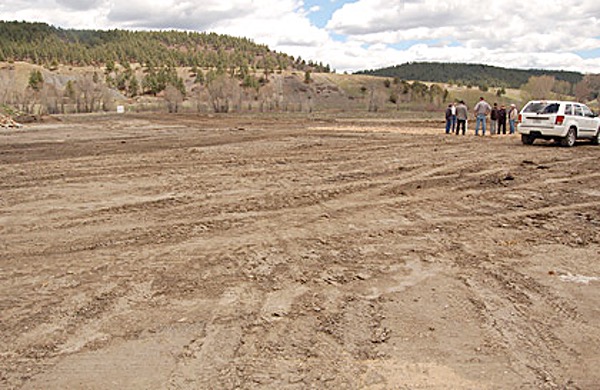A friend of mine who lives out in the unincorporated county has been experiencing issues this past year with her septic system, which was installed when her house was originally built, back in the early 1980s. During her struggle to remedy the (terribly inconvenient) issues, she has discovered that she apparently purchased a house without a legal septic system — in fact, a system that was permitted only as a ‘temporary’ system — even though, back when she was considering the purchase of this particular home in the mid-2000s, she was assured by the regulatory folks at San Juan Basin Health Department that the system was legal and fully permitted, according to their records from the early 1980s.
San Juan Basin Health Department has since changed its name — it’s now San Juan Basin Public Health — and the staff there has changed, and we can probably feel confident that an illegal septic system would not be approved in the year 2020. In fact, the rules for buying and selling homes with existing onsite wastewater treatment systems — OWTS, better known as septic systems — have changed rather dramatically. Beginning January 1, 2019, most septic systems in Archuleta, La Plata and San Juan Counties must be inspected prior to the sale of the home.
There are a few exceptions, but practically speaking, pretty much any ‘arms length’ sale of a home with a septic system must have its system inspected prior to the sale.
How about wintertime inspections? From a Coldwell Banker real estate website:
When snow covers the ground, it can be difficult or even impossible to inspect an on-site wastewater treatment system. Freezing temperatures compound the problem by causing the ground to freeze, halting repair projects and anything requiring digging. To avoid delays caused by cold weather, San Juan Basin Public Health recommends getting inspections done in advance. When this isn’t possible, a Coldwell Banker Realtor can help you navigate the process and make informed decisions as a buyer or seller…
…Our knowledgeable brokers are ready to help you navigate these new rules, find a certified inspector, and submit the required septic system inspection paperwork, whether you’re buying or selling a home…
I have no idea how many homes in Archuleta County have septic systems, and how many are hooked up to the Pagosa Area Water and Sanitation (PAWSD) waste water treatment plant. About eight years ago, when the Water Supply Community Work Group was researching the controversial Dry Gulch Reservoir proposal, were were told that maybe 75 percent of the homes in Archuleta County were hooked up to PAWSD water. (No one had an exact number.) That suggests that 25 percent of our homes are served by small, neighborhood treatment plants or by septic systems.
Maybe 3,000 homes with septic systems? I’m just guessing.
And I would be guessing if I suggested the number of systems that are currently illegal.
But this editorial series is not meant to address private septic systems. We have bigger fish to fry. We’re talking instead about a municipal waste water system within the Town of Pagosa Springs, full-time population approximately 1,900. Maybe 800 homes? The majority of those homes were once connected to three ‘sewer lagoons’ located on 26 acres of riverfront property just south of Yamaguchi Park, just east of Pagosa Springs High School. In the early 2000s, the lagoons were leaching certain chemicals — particularly ammonia — into the San Juan River, and the Town government was scrambling to finance a new state-of-the-art treatment plant for its gravity-fed system.
In the spring of 2011, it looked like we had the financing in place to build that new treatment facility. The site, near the sewer lagoons, was being prepared, and Jim Isgar had pulled some political strings to get us the necessary grants and loans. The setting wasn’t entirely beautiful. But it wasn’t entirely distasteful either.

Jim Isgar, Colorado’s State Director of USDA Rural Development — and former State Senator for District 6 — stood on fresh fill dirt near the Town’s southern border, adding his signature to a three-foot-long piece of plastic pipe during a fairly casual “media photo opportunity” yesterday. (Mr. Isgar explained that the “Enormous Check” photo opportunity had been replaced, for water projects, with the “Big Piece of Plastic Pipe” photo opportunity.)
Joining Mr. Isgar for a brief ceremony were a handful of others: Ross Aragon, Pagosa’s longtime mayor; Phil Starks, supervisor of the Pagosa Springs Sanitation General Improvement District; Duane Dale, USDA Rural Development specialist; and Patrick O’Brien, lead engineer on the design of the Town’s new $6 million sewer treatment plant. Everyone was smiling.

Also present at the brief ceremony were Town Council members Darrel Cotton and Shari Pierce, though both declined to pose in the photos. Mr. Cotton had been the lone “No” vote in approving Town’s acceptance of a $3.9 million USDA loan and grant package — money was right now being officially celebrated.
$3.9 million from USDA would be combined with a $2 million loan from the Colorado Water Resources and Power Development Authority and a $1.25 million grant from the Department of Local Affairs.

The final cost of the new sewer treatment plant had not yet been determined, and in fact, we would never learn an exact price, because this was right about the time when the project management staff from PAWSD began selling the Mayor and Town Council on a cheaper, and supposedly better, alternative: a 7-mile-long pipeline to pump the Town’s sewage uphill to the Vista Treatment Plant.
I lay in bed this morning, trying to understand how the engineers from Topeka, Kansas-based Bartlett & West — the engineers who subsequently designed the ‘force main’ system that is now producing harmful levels of hydrosulfuric acid that can corrode metal parts in the system’s two pump houses and are causing unpleasant odors in suburban neighborhoods uptown — how the engineers could design a system like this, and not know the problems that would soon arise. Or, if they knew, how they could keep the knowledge secret from the taxpayers.
And I thought about the attempted solutions that have been proposed to the Town Council. The solution that the Council approved last week — a combination of oxygen injection and air treatment, proposed by a Minnesota company called Syneco Systems — might work, and it might not.
Is it likely to work? I ask that question, because the solution appears to have a $1 million price tag, over the next two decades. To be paid by me, and the rest of the downtown property owners…
Read Part Six, tomorrow…

